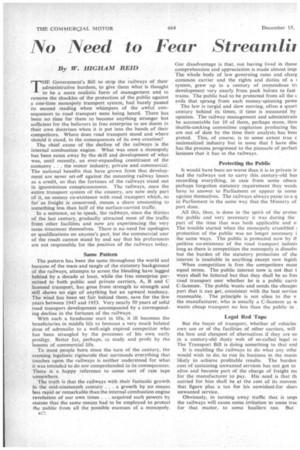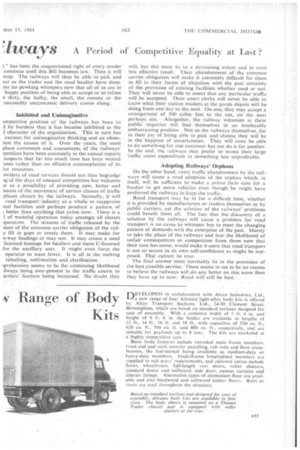No Need to Fear Streamlit
Page 46

Page 47

If you've noticed an error in this article please click here to report it so we can fix it.
r ways A Period of Competitive Equality at Last ?
By W. HIGHAM REID
THE Government's Bill to strip the railways of their administrative burdens, to give them what is thought to be a more realistic form of management and to .remove the shackles of the protection of the public against a one-time monopoly transport system, had barely passed its second reading when whimpers of the awful consequences to road transport were being. heard. There has been no time for them to become anything stronger but sufficient for the believers in free enterprise to see doom in their own doctrines when it is put into the hands of their competitors. Where does road transport stand and where should it stand, in the consequences of its own creation?
The chief cause of the decline of the railways is the internal combustion engine. What was once a monopoly has been eaten away by the skill and development of what was, until recently, an ever-expanding constituent of the economy . . . the motor industry, private and commercial. The national benefits that have grown from that development are never set-off against the mounting railway losses as a credit, so that the fortunes of the railways stand out in ignominious conspicuousness. The railways, once the entire transport system of the country, are now only part of it, an uneasy co-existence with road transport which, so far as freight is concerned, means a share amounting to something less than half of the surface-carried traffic.
In a sentence, so to speak, the railways, since the thirties of the last century, gradually attracted most of the traffic from other facilities and now are experiencing the very same treatment themselves. There is no need for apologies or qualifications on anyone's part, but the commercial user of the roads cannot stand by and say that his preferences are not responsible for the position of the railways today.
Same Pattern The pattern has been the same throughout the world and because of the mass and tangle of the statutory background of the railways, attempts to arrest the bleeding have Jagged behind by a decade at least, while the free enterprise permitted to both public and private carriers, A, B and C licensed transport, has gone from strength to strength and still shows no sign of anything but an upward tendency. The wind has been set fair behind them, save for the few years between 1947 and 1953. Very nearly 50 years of solid road transport development accompanied by a corresponding decline in the fortunes of the railways.
With such a handsome start in life, it ill becomes the beneficiaries in middle life to bemoan a very much belated dose of adrenalin to a well-nigh expired competitor who has been strangled by the processes of his own early prodigy. Better far, perhaps, to study and profit by the lessons of commercial life.
To most people born since the turn of the century, the seeming legalistic rigmarole that surrounds everything that touches upon the railways is neither understood for what it was intended to do nor comprehended in its consequences. There is a happy reference to some sort of rate tape somewhere.
The truth is that the railways with their fantastic growth in the mid-nineteenth century . . . a growth by no means less rapid or remarkable than the internal combustion engine revolution of our own times . . . acquired such powers by statute that the same means had to be employed to protect the public from all the possible excesses of a monopoly.
n12
Our disadvantage is that, not having lived in those comprehension and appreciation is made almost imp' The whole body of law governing rates and charg common carrier and the rights and duties of a 1 system, grew up in a century of tremendous tn development very nearly from pack horses to fast trains. The public had to be protected from all the c evils that sprang from such money-spinning powe
The law is turgid and slow moving, often a quart century behind its times, if time is measured by opinion. The railway management and administratii be accountable for 10 of them, perhaps more, thro shuttle-cocking committee cogitation producing fac are out of date by the time their analysis has beer preted. This, of course, is to some extent true c nationalized industry but in none that I have disc has the process progressed to the pinnacle of perfect lessnessthat it has in the railways.
Protecting the Public
It would have been no worse than it is in private in had the railways not to carry this century-old bui recording everything, in case from some obscu. perhaps forgotten statutory requirement they woulc have to answer to Parliament or appear in some against themselves. The railways always panic to .a q in Parliament in the same way that the Ministry of port does.
All this, then, is done in the spirit of the protec the public and very necessary it was during the part of the time that was both applicable and el The trouble started when the monopoly crumbled protection of the, public was no longer necessary i the same ways. The public is protected now by th petitive co-existence of the road transport industi long as there is competition the monopoly is dissolvi but the burden of the statutory protection of the interest is insoluble in anything except new legish When competition is free the competitors must equal terms. The public interest now is not that t ways shall be fettered but that they shall be as fret road transport user whether he is a public carrii C-licensee. The public wants and needs the cheapet port that it can get, consistent with the best service reasonable. The principle is not alien to the v the manufacturer, who is usually a C-licensee as w wants cheap transport no less than the public in ,
Legal Red Tape
But the buyer of transport, whether of vehicles own use or of the facilities of other carriers, will the best and cheapest of alternatives if they are en in a century-old dusty web of so-called legal re The Transport Bill is doing something to that end
It is enabling the railways to do what any othe: would wish to do, to run its business in the mann likely to achieve profitable results. The burden cost of sustaining unwanted services has not got to alive and become part of the charge of freight mr for the manufacturer to pay. His need is that th carried for him shall be at the cost of its movem. that figure plus a tax for hisunwished-for shar4 unwanted service.
Obviously, in turning away' traffie that is unpi the railways will cause some irritation to some trac for that matter, to some hauliers too. But
" has been the unquestioned right of every sender continue until this Bill becomes law. Then it will stop. The railways will then be able to pick and ust as the trader and the road haulier have done. 3ar no pewking whimpers now that all of us are in happy position of being able to accept or to refuse e "dirty, the bulky, the small, the remote or the -easonably uneconomic delivery comes along.
Inhibited and Unimaginative
ompetitive positionof the railways has been so d by burdens that it has become inhibited in the character of the organization, This in turn has excuses for unimaginative thinking and an obsesinst the causes of it. Over the years, the most place comments and assessments of the railways' ipetition have been constantly in the annual reports suspects that far too much time has been wasted uses rather than on effective contemplation of its ive resources.
oviders of road services should not then begrudge ig of the days of unequal competition but welcome st as a possibility of providing new, better and neans of the movement of certain classes of traffic places chosen by the railways. Secondly, it will road transport industry as a whole to reappraise Pnal facilities and perhaps produce a pattern of I better than anything that exists now. There is a 1 of wasteful operation today amongst all classes verators. The streams of traffic released by the nent of the common carrier obligation of the raily fill in gaps or create them. It may make for o-way loadings or may not. It may create a need licensed tonnage for hauliers and more C-licensed for the ancillary user. It might even force the operator to want fewer. It is all in the melting rebolling,. sublimation and clarification.
'prehension seems to be the continuing likelihood ilways .being ever-present in the traffic courts to arriers' licences being increased. No doubt they
will, but this must be to a decreasing extent and to even less effective result. Their abandonment of the common carrier obligation will make it extremely difficult for them to fill in their forms of objection with the past certainty of the provision of existing facilities whether used or not. They will never be able to assert that any particular traffic will be accepted. Their court clerks will never beable to know. what their station masters at the goods depots will be doing from one.day to the next. On one, they may accept a consignment of 500 cubic feet to ' the ton, on the next perhaps not. • Altogether,' the railway witnesses at these public inquiries will find themselves in an intolerably embarrassing position. Not so the railways themselves, for in their joy of being able to pick and choose they will be in the happiest of uncertainties. They will even be able to do something for one customer but not do it for another. In the end, the railways may prefer to invest their large traffic court expenditure in something less unprofitable.
Adopting Railways' Orphans On the other hand, every traffic abandonment by the railways will cause a road adoption of the orphan which, in itself, will be sufficient to make a prima fade case for a haulier to get more vehicles even though he might have preferred the railways to keep the traffic.
Road transport may be in for a difficult time, whether it is provided by manufacturers or traders themselves or by public carriers, yet the solution of the railways' problems could benefit them all. The fact that the discovery of a solution by the railways will cause a problem for road transport is no cause to whimper but to meet the changing pattern of demands with the enterprise of the past. Merely to take the place of the railways and fear the likelihood of unfair consequences or competition from them now that their turn has come, would make it seem that road transport is not so secure in its own self-confidence as might be sup
posed. That cannot be true. •
The final answer must inevitably lie in the provision of the best possible service. There seems to me to be no reason to believe the railways will do any better on this score than they have .up to now.Road will still be -best.




















































































































